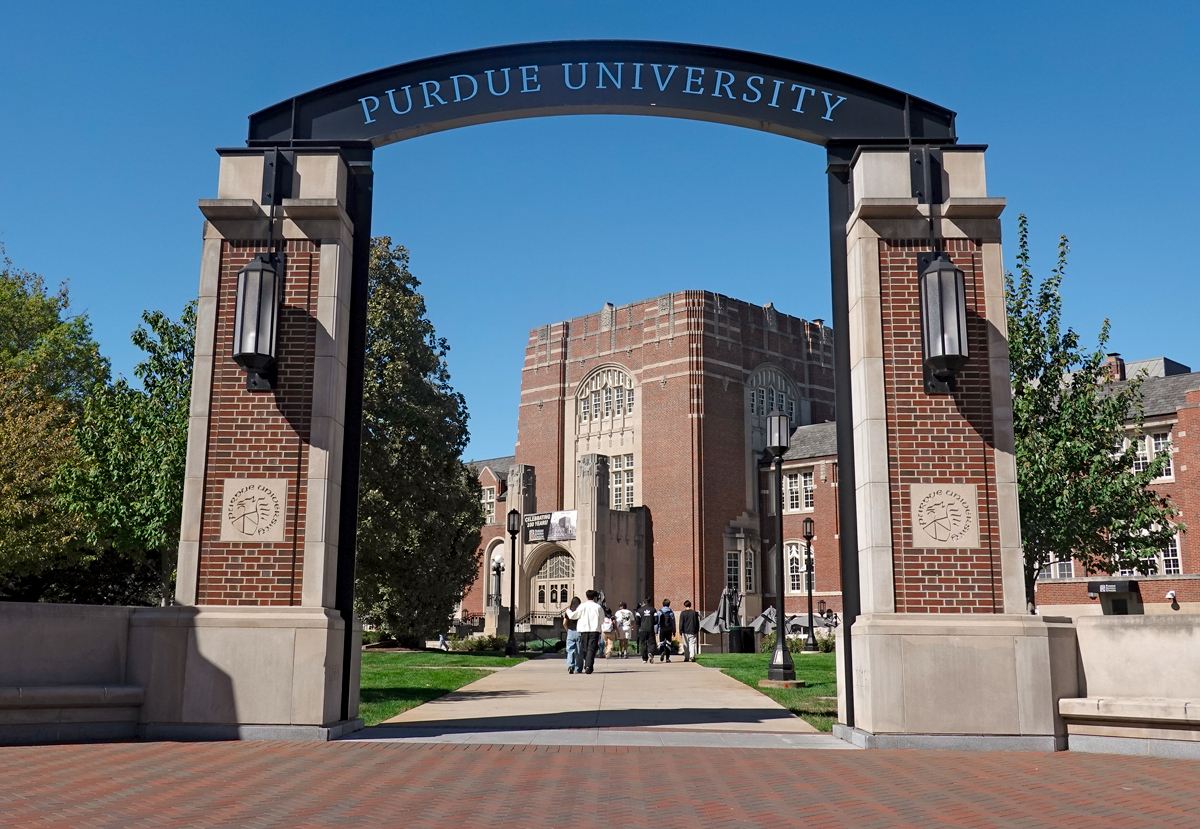Subscriber Benefit
As a subscriber you can listen to articles at work, in the car, or while you work out. Subscribe Now
Purdue University leaders are hard at work laying the groundwork to make South Korean chip manufacturer SK Hynix’s U.S. expansion in West Lafayette a success.
Although SK Hynix is still four years from launching its $3.87 billion semiconductor packaging facility, the university is already planning infrastructure expansion, coordinating a flood of interest from potential supply-chain partners, mitigating construction headaches, forging research partnerships and building its workforce development pipeline.
SK Hynix announced plans in April to build its first fabrication facility outside South Korea at the Purdue Research Park. The 430,000-square-foot building spanning 90 acres is expected to employ at least 800 people by 2030. It will make next-generation high-bandwidth-memory, or HBM, chips—critical components of graphic processing units that train artificial intelligence systems such as ChatGPT. It will be the first-of-its-kind, large-scale facility in the United States.

Construction is expected to kick off next year, and the company plans to begin production in the second half of 2028.
“It was an amazingly challenging effort to win the business, but the heavy work lies before us,” Purdue Research Foundation President Brian Edelman told IBJ.
“We are moving forward with the construction of the Indiana production base, working with the State of Indiana, Purdue University and our U.S. business partners to ultimately supply leading-edge AI memory products from West Lafayette,” SK Hynix told IBJ last month in a written statement.
When a major semiconductor producer builds a fabrication facility, companies involved in the supply chain—from design to research to production—often want to be nearby. Those suppliers could include advanced-packaging partners, machine mechanics and suppliers, design houses, R&D facilities, smaller suppliers, and startups.
An example of this is playing out in a Columbus, Ohio, suburb where Intel is building two semiconductor fabrication facilities. Intel is expected to create 3,000 jobs there, but the project is expected to employ 20,000 people through supporting businesses.

In greater West Lafayette, the SK Hynix project is expected to create 3,000 to 5,000 jobs at full buildout.
“Curated densification” is the goal for building that type of ecosystem at the Purdue Research Park, Purdue President Mung Chiang told IBJ. Locating the right industry stakeholders close to one another will increase Purdue’s return on investment, he said.
Currently, Purdue leaders are seeing interest from stakeholders across the semiconductor industry—including equipment manufacturers and customers. And the university is recruiting a handful of supply-chain companies to open facilities in West Lafayette.
“I now go around telling the interested companies that you need to hurry up,” Chiang said. “Space is limited.”
Right now, Edelman said, Purdue is tracking and compiling inquiries to discuss with the SK Hynix team once it visits Indiana later this month to work on kicking off the Indiana operation.
“There has been a massive interest from all aspects associated with the project of working with SK Hynix,” he said.
The Purdue Research Park covers 725 acres and has more than 50 buildings that employee 3,200 people. About 300 acres are available for SK Hynix and any companies interested in locating near it.
Alongside the IEDC and others, Purdue spent more than two years trying to land the mega deal and touted its talent pipeline and commitment to innovation as well as Indiana’s history of collaboration among state and local government and universities.
Now, it has to deliver.
Already, Purdue faculty and staff are working to identify and tackle potential construction challenges—like shortages in materials or in workforce housing for the estimated 2,000 workers at construction peak.
And eventually, SK Hynix will move upward of 200 South Korean citizens to West Lafayette. Purdue is committed to helping them settle, which could involve community outreach, finding child care and more.
The balls have started rolling to get the facility online by 2028, Chiang told IBJ.
“The secret sauce for any economic development deal comes down to this mindset and to this agility and speed—the mindset that your success is our success, your problems are our problems,” he said. “They see it, they feel it, and they trust that they can work with us as long-term partners across many dimensions.”
The university is also expected to be involved in SK Hynix’s research and discovery efforts, including its work in combining processing and memory storage in computing and in building generative AI models.
Chiang said he is looking forward to the AI research opportunities that a partnership with SK Hynix will bring since the company produces specific chips that are the most conducive to training AI.
Purdue “will play an important role in the U.S. semiconductor ecosystem and advancing U.S. technological leadership,” the Commerce Department said in August when it awarded SK Hynix up to $450 million of 2022 CHIPS Act support for its West Lafayette project. That funding was on top of an initial $700 million incentives package from the Indiana Economic Development Corp.
Faculty and staff are working to finalize a university research partnership agreement, CHIPS Act research proposals and collaborative research projects.
Even before the SK Hynix deal, West Lafayette was becoming a hub for semiconductor research and development.
The Purdue Discovery Park is home to the Birck Nanotechnology Center, which has a 25,000-square-foot clean room that supports microelectronics research. Current education efforts include a program development partnership with Ivy Tech Community College, an intensive hands-on internship and the federal SCALE program, which prepares students for a microelectronics career in defense. (SCALE stands for Scalable Asymmetric Lifecycle Engagement.)
When the SK Hynix plant opens, the university expects to see a surge in student interest (the SK Hynix partnership will give more students internship and co-op opportunities), faculty recruitment and research opportunities—especially in data science and artificial intelligence.

“When you have the ability to reach one of the No. 1 AI chipmakers right in your backyard, that makes people want to come here,” said Karen Plaut, Purdue’s executive vice president for research.
The university already does chip-fabrication research, Plaut said, but SK Hynix’s facilities will allow researchers to see the real-world application. Purdue’s current research partners are thrilled as well to have a major player come into the ecosystem that offers large-scale growth opportunities, she said.
“Now you have people thinking about research ideas put together with people who have to put that into practice,” Plaut said. “There’s a whole different level when you have to put that into practice.”•
Please enable JavaScript to view this content.

